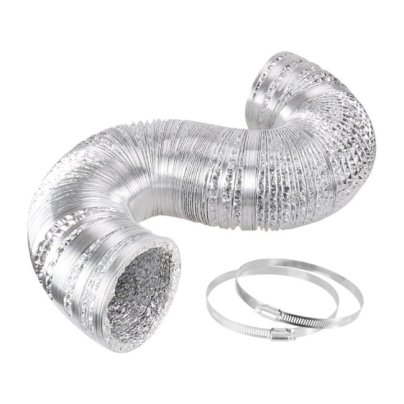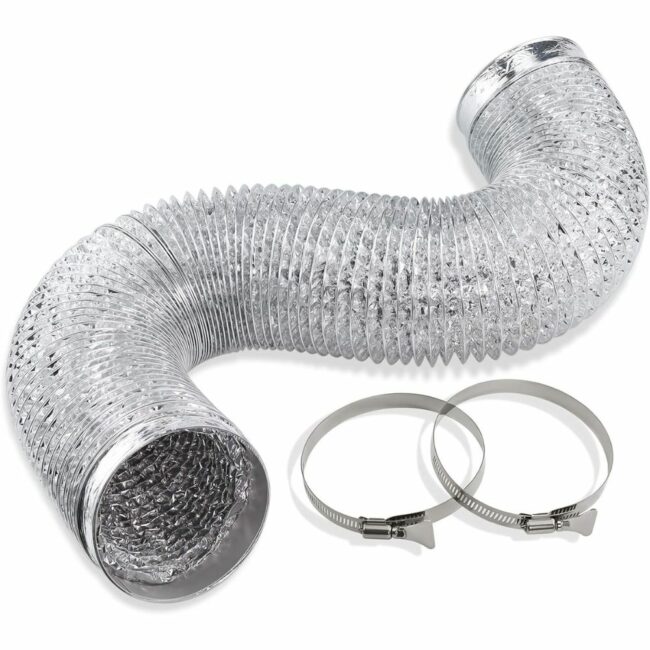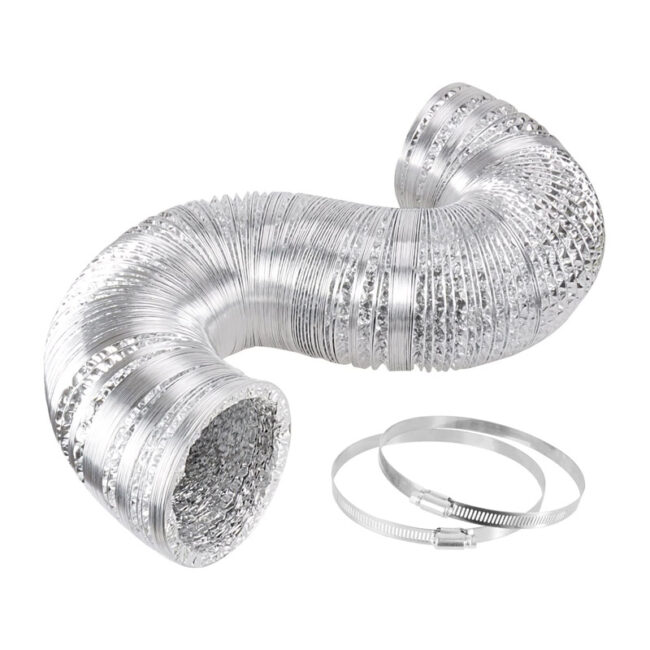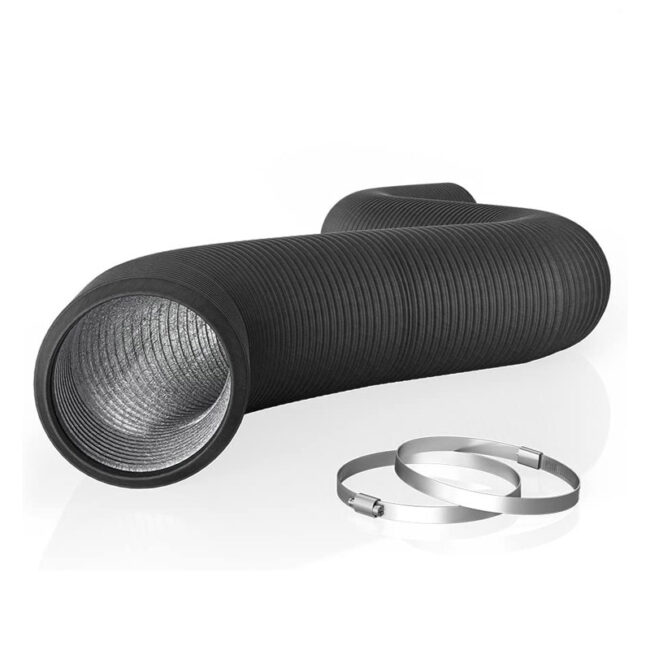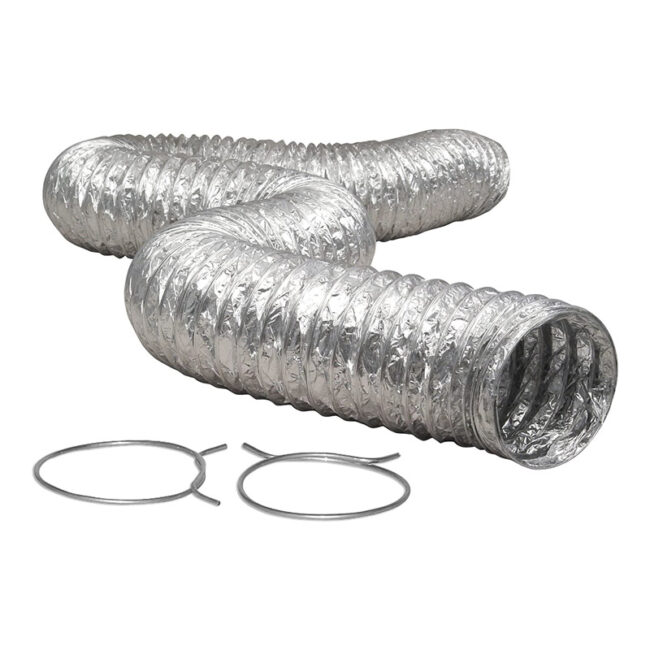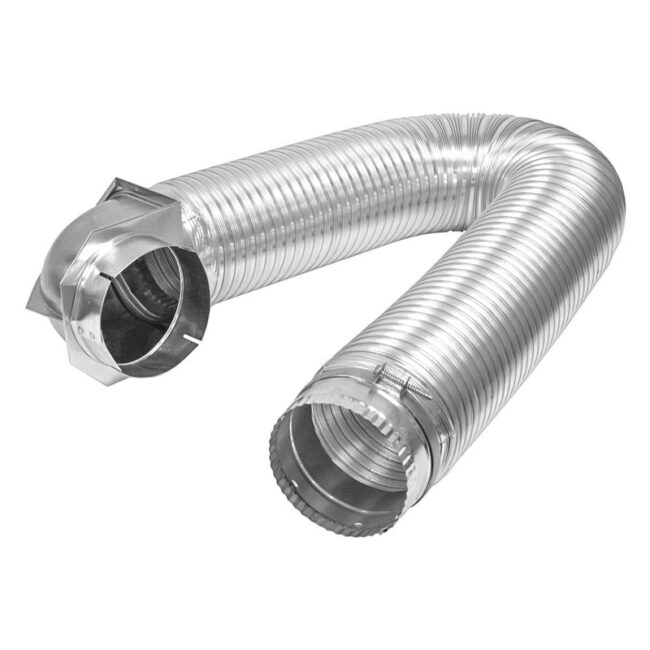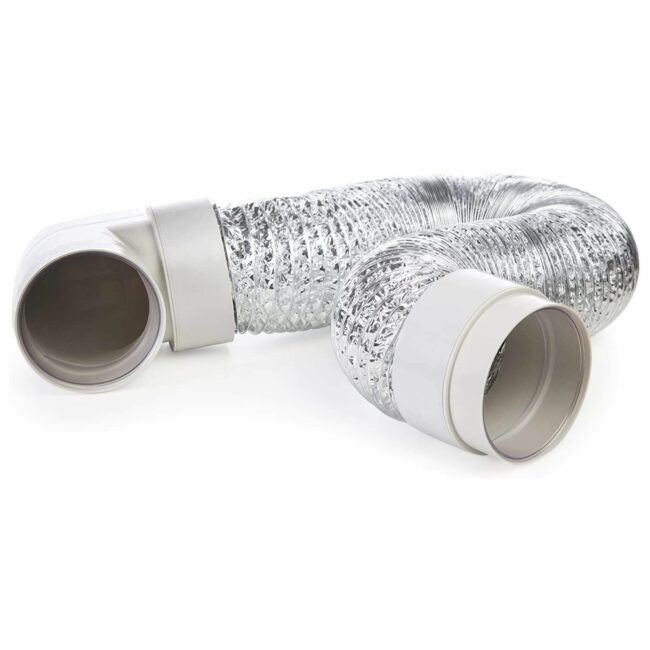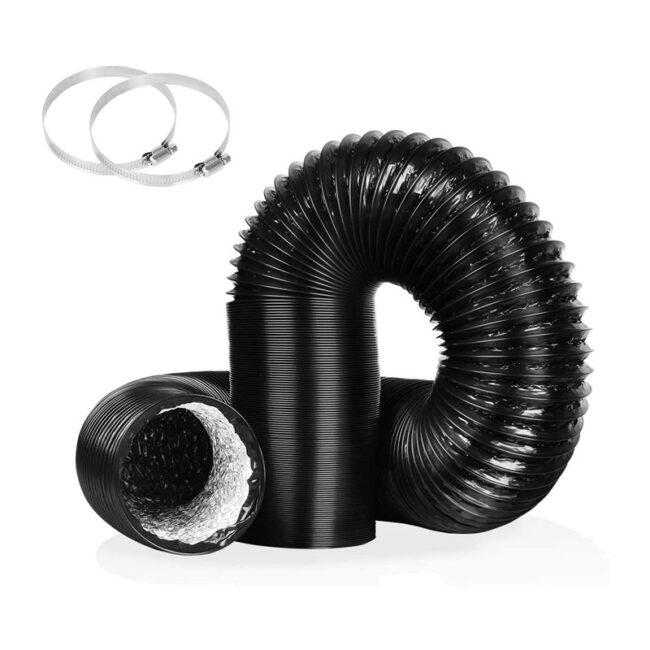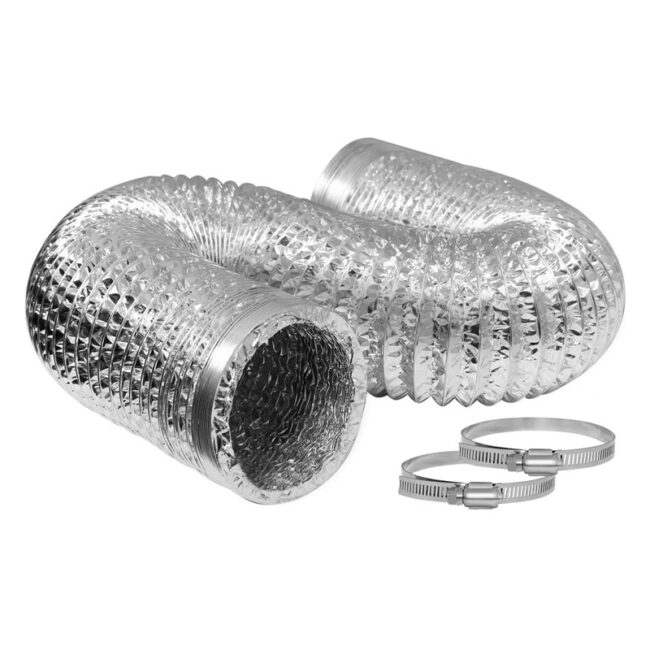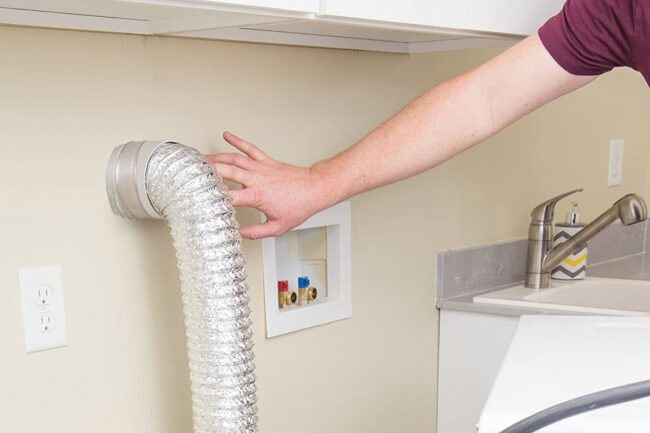
We may earn revenue from the products available on this page and participate in affiliate programs. Learn More ›
According to the U.S. Fire Administration, there are approximately 2,900 dryer fires in homes each year. Thirty-four percent of those fires start because someone forgot to clean the dryer vent. Finding the best dryer vent hose, installing it properly, and cleaning it regularly are important to ensure proper ventilation of your dryer and to reduce the risk of a fire.
If your dryer is in a tight spot, it can be challenging to find the right dryer vent hose for the task. Use this guide to help you as you shop for the best dryer vent hose for tight spaces. In addition to information on what to look for, included is a list of some of the top products on the market.
- BEST OVERALL: Cenipar Flexible Aluminum Dryer Vent Hose
- BEST BANG FOR THE BUCK: iPower Aluminum Foil Ducting Dryer Vent Hose
- BEST EXTRA-LONG: AC Infinity Flexible Ducting Dryer Vent Hose
- BEST FLEXIBLE: Dundas Jafine ProFlex Dryer Vent Hose
- BEST SEMIRIGID: Builder’s Best Single Elbow Dryer Vent Duct Kit
- EASIEST TO INSTALL: Ziggurat Products Cinch Ace Dryer Vent Kit
- HONORABLE MENTION: Yijuhou Noninsulated Aluminum Dryer Vent Hose
- ALSO CONSIDER: Vivohome Flexible Aluminum Dryer Vent Hose
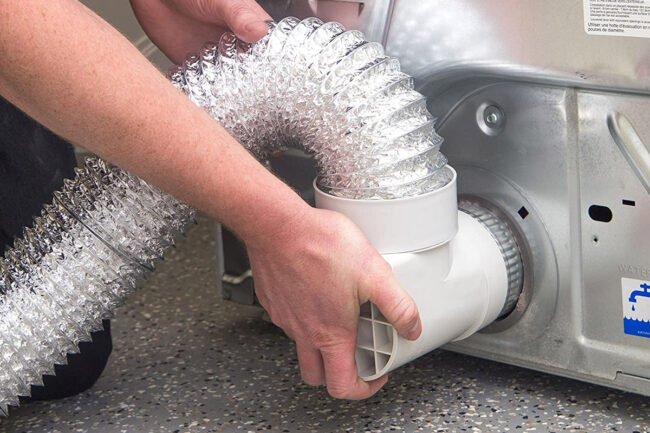
How We Chose the Best Dryer Vent Hoses for Tight Spaces
Vent hoses are relatively straightforward products to shop for. However, there are certain differences that shoppers can consider, depending on what exactly they are looking for. Our list of recommendations covers a range of materials, from semirigid aluminum and metal vents to the more budget-friendly foil alternative, as well as some with special PVC protective coatings for added stability and protection. Our top picks are all made from quality materials from reputable brands and will comfortably fit standard ductwork diameters with very simple installation.
Our Top Picks
Read on to discover some of the best dryer vent hoses for tight spaces, according to the shopping considerations outlined below. A mix of dryer vent sizes and types are featured to ensure there’s a vent for every laundry room, no matter the size.
Best Overall
Cenipar Flexible Aluminum Dryer Vent Hose
Pros
- Flexible aluminum construction can be retracted or extended to desired length (up to 8 feet)
- Flame-retardant and corrosion-resistant construction can withstand temperatures up to 185 degrees Fahrenheit
- A smooth interior prevents any dust or lint buildup to allow for optimal airflow
Cons
- Does not come with a UL listing, which may be important to some users
Product Specs
- Type: Flexible aluminum foil
- Length: 8 feet (other sizes are available)
- UL certification? No
Cenipar’s dryer vent hose includes an 8-foot transition vent with a 4-inch diameter. The compact design features a flexible aluminum construction for durability and safety, and the smooth interior prevents lint from building up as it might in more textured vents. The hose is also durable and resists crushing to ensure maximum airflow and venting.
The dryer vent hose also comes with two connectors on each end that make it possible to move the dryer without completely disconnecting the hose. This model is also flame-retardant, corrosion-resistant, and capable of withstanding temperatures of up to 185 degrees Fahrenheit.
Get the Cenipar dryer vent hose at Amazon.
Best Bang For The Buck
iPower Aluminum Foil Ducting Dryer Vent Hose
Pros
- Easy installation compared with other options on the market; simply install with the 2 stainless steel clips
- Suitable for various applications; can be used for dryers, hydroponics, and more
- The most affordable option included on this list
Cons
- Some users have reported that the foil feels quite flimsy and tears easily
- No UL listing to be found, which may be important for some shoppers
Product Specs
- Type: Flexible aluminum foil
- Length: 8 feet (other sizes are available)
- UL certification? No
This flexible dryer vent hose from iPower is an economically priced choice to consider. The hose has a 4-foot diameter with an 8-foot length to accommodate the venting needs of many in-home dryers. A pair of 4-inch metal clamps are included with this dryer vent hose to allow for simple installation.
The dryer vent hose boasts a thermal endurance range of 0 to 185 degrees Fahrenheit. It’s constructed from flame-retardant aluminum material with a fireproof coating for additional peace of mind. A corrosion-resistant wire helix adds stability and reinforcement for enhanced performance and longevity.
Get the iPower dryer vent hose at Amazon.
Best Extra Long
AC Infinity Flexible Ducting Dryer Vent Hose
Pros
- Extra-long hose provides over 25 feet of reach if desired
- Spiral steel wire provides added support and flexibility
- Comes with 2 stainless steel duct clamps for ease of installation
- Tear-resistant PVC covering and 4-layer design provide long-term use and reliability
Cons
- Struggles to fit on standard 4-inch dryer ducts
Product Specs
- Type: Flexible PVC and aluminum foil
- Length: 25 feet
- UL certification? No
The AC Infinity aluminum dryer vent hose offers a long length of 25 feet that can be shortened as needed. It also has a 4-inch diameter to allow for a secure fit on most dryers. Two stainless steel duct clamps are included with the hose.
This dryer vent hose features a unique four-layer design for enhanced durability and resistance against tears. It boasts flame-resistant aluminum foil construction with a smooth interior for optimal airflow. The dryer vent hose also has a spiral steel wire integrated into its design for added support and easier installation. A no-tear PVC thermoplastic covers the aluminum to enhance durability.
Get the AC Infinity dryer vent hose at Amazon or Walmart.
Best Flexible
Dundas Jafine ProFlex Dryer Vent Hose
Pros
- Durable 4-ply aluminum foil construction provides long-term use; resists corrosion and combustion
- 8-foot length can be expanded or retracted to fit in a given space
- Wire helix helps retain shape and structure
Cons
- Included clamps may need replacing; not as durable or thick as some comparable options
Product Specs
- Type: Flexible aluminum foil
- Length: 8 feet
- UL certification? Yes, UL listed
The Dundas Jafine dryer vent hose is made from a flexible and durable four-ply aluminum foil laminate. This heavy-duty material is long-lasting and fire-resistant for peace of mind. A corrosion-resistant wire helix gives the dryer vent hose its structure and shape and allows for easy positioning and routing in a laundry room. The wire helix also helps to ensure an airtight seal with the dryer.
This dryer vent hose is UL-listed and suitable for use with both the electric and gas valves of dryers. It’s 8 feet long with a 4-inch diameter, and two clamps are included to connect the hose to the dryer and the vent leaving the house.
Get the Dundas Jafine dryer vent hose at Amazon.
Best SemiRigid
Builder’s Best Single Elbow Dryer Vent Duct Kit
Pros
- Reduces lint buildup to maintain proper airflow and effectiveness
- Handles very high temperatures of up to 430 degrees Fahrenheit
- Comes with a single-elbow design which allows for 90-degree turns
Cons
- Some users have reported that it’s not truly 8 feet long, which may make it unsuitable for users that need that extra length
Product Specs
- Type: Aluminum
- Length: 8 feet
- UL certification? Yes, UL listed
Those looking for a semirigid dryer vent hose may want to consider this 8-foot transition duct from Builder’s Best. The dryer vent hose has a 4-inch diameter and includes one closed elbow to make a 90-degree turn in a laundry room. Two clamps are also included for connecting the hose.
This product is UL-listed to comply with recommendations for proper venting of a dryer. The smoother interior reduces lint buildup to lower the risk of a dryer fire. The dryer vent hose can handle temperatures up to 430 degrees Fahrenheit.
Get the Builder’s Best dryer vent hose kit at Amazon.
Easiest To Install
Ziggurat Products Cinch Ace Dryer Vent Kit
Pros
- Easy snap-on installation; does not require the typical metal clamps
- Straight and elbow connectors included for a variety of installation needs
- Flexible yet durable rubber material can attach to the hose easily
Cons
- Installation instructions can be confusing for first-timers
- May not be compliant with some building codes
Product Specs
- Type: Plastic connector with foil hose
- Length: 8 feet
- UL certification? No
The Ziggurat Products dryer vent hookup kit is designed to simplify the process of connecting a dryer vent hose. The kit includes an 8-foot flexible dryer vent hose with a 4-inch diameter, one 90-degree elbow connector, and one straight connector. The elbow and straight connectors snap onto the included dryer vent hose (or other flexible or rigid hoses) and then easily connect to the dryer; the assembly and installation process can be completed quickly.
The connectors in this kit are made from a soft yet durable rubber material to ensure a snug and secure attachment for proper and safe ventilation. The hose is also designed with durability in mind and resists ripping and crushing.
Get the Ziggurat Products dryer vent hose kit at Amazon.
Honorable Mention
Yijuhou Noninsulated Aluminum Dryer Vent Hose
Pros
- Durable PVC and aluminum layers prevent tearing and comes with fire-resistance capabilities
- A stainless steel wire keeps the hose in position while in use
- Can withstand temperatures ranging from -30 to 150 degrees Fahrenheit
Cons
- Can be difficult to fit on a regular 4-inch duct
Product Specs
- Type: Flexible PVC, steel, and aluminum foil
- Length: 16 feet
- UL certification? No
This Yijuhou dryer vent hose offers a 16-foot length with a 4-inch diameter. The hose boasts a three-layer construction for enhanced durability. A double aluminum foil interior is covered with a black PVC film to create a lightweight and tear-resistant dryer vent hose. A steel wire is also integrated into the design to add additional structure and stability while also allowing individuals to position the hose as desired without the need for rigid elbow connectors.
This dryer vent hose is flame-resistant and will not release any toxic gases, even at high temperatures. It can resist temperatures between -30 and 150 degrees Fahrenheit.
Get the Yijuhou dryer vent hose at Amazon.
Also Consider
Vivohome Flexible Aluminum Dryer Vent Hose
Pros
- Extra-long hose provides plenty of versatility for multiple types of applications
- Fast installation; comes with 2 included metal screw clamps
- Endures a wide range of temperatures ranging from -22 to 266 degrees Fahrenheit; comes with a flame-retardant coating
Cons
- Struggles to fit a standard 4-inch vent
Product Specs
- Type: Flexible aluminum foil
- Length: 25 feet
- UL certification? No
Vivohome’s flexible dryer vent hose has a 4-inch diameter with a 25-foot length to meet the demands of laundry rooms where the dryer vent hose may need to travel a distance to get to the outside of the home. This hose is constructed from two layers of heavy-duty aluminum foil with a central PET laminate layer.
The exterior of the dryer vent hose features a flame-retardant coating. It is able to endure temperatures ranging from -22 to 266 degrees Fahrenheit. Installation of this model is quick and easy using the two included metal screw clamps.
Get the Vivohome dryer vent hose at Amazon or Walmart (2-pack).
Jump to Our Top Picks
What to Consider When Choosing a Dryer Vent Hose for Tight Spaces
There are quite a few dryer vent hoses on the market. As you shop, consider the type and size of each hose, whether it’s UL certified, the connectors or other accessories that come with the hose, the path the hose will take in your home, and the installation process.
Type
When shopping for a new dryer vent hose, you’ll need to decide on the type of dryer vent hose required. Dryer vent hoses are available in several types, including:
- Aluminum foil: Aluminum foil dryer vent hoses have a flexible design and are between 1 and 8 feet long. Their flexible design is easy to route between the dryer and the exit—no elbow connector pieces needed. Aluminum foil dryer vent hoses should only be used for transition ducts and should not be used for concealed ducts inside of walls or other areas. Aluminum foil hoses are typically heat resistant up to 150 degrees Fahrenheit and are usually inexpensive.
- Semirigid metal: Semirigid dryer vent hoses, as the name implies, have a more rigid structure than their aluminum counterparts. Thanks to their rigid design, elbow connectors are needed when a bend in the dryer vent hose is necessary to complete the path to the exit or another duct. This material should also only be used for transition ducts, not inside walls. Semirigid hoses have a smoother interior than aluminum foil, plastic, or vinyl ducts, which means they catch less lint to lessen the chance of a fire. However, this material choice is often more expensive than aluminum foil, plastic, or vinyl hoses. Semirigid ducts can resist temperatures up to 400 degrees Fahrenheit and are the preferred choice of many dryer manufacturers.
- Rigid metal: Rigid metal ducts are the only type of dryer vent hose that’s allowed to be concealed within a wall. These ducts, which are made from either aluminum or galvanized steel, cannot be bent, unlike hoses made from other materials. Their design provides a smooth interior that allows for maximum airflow and does not trap lint. Elbow joints are required to accommodate turns in the path. These ducts are heat resistant up to 400 degrees Fahrenheit.
- Plastic or vinyl: Plastic or vinyl dryer vent hoses are not recommended, and most building codes do not allow them. They offer a flexible design, similar to an aluminum foil hose. However, the textured interior of these hoses traps lint, which creates a fire hazard. Most models can resist temperatures up to 140 degrees Fahrenheit.
Size and Compatibility
Next, determine what size dryer vent hose you will need for your dryer. Determine the path the hose will need to take to get from the base of the dryer to the exit point or other ductwork, and measure to determine how much length is necessary to cover this path. In addition to its length, consider its diameter. Most dryers require a hose with a 4-inch diameter. To ensure you’re choosing the right hose, double-check the information provided by the dryer manufacturer.
You’ll also need to confirm that the dryer vent hose is compatible with your dryer. Most hoses will work with gas and electric dryers, but it’s best to check with the manufacturer’s specifications before making a purchase.
UL Certification
Some dryer vent hoses are UL listed. UL, which stands for Underwriters Laboratories, offers third-party certification to identify products that meet more stringent criteria, making UL-listed options the safest choice for a dryer vent hose. UL-listed transition hoses meet the following criteria:
- They must not pass through any walls, floors, or other concealed spaces.
- Transition ducts cannot have a length that’s longer than 8 feet.
- Transition ducts must be one single length; multiple sections cannot be connected together.
Connectors
Connectors may be required to properly attach a dryer vent hose to a dryer. Most dryer vent hoses will include a connector or clamps, while others may not. If these accessories are included with the hose you’d like to purchase, confirm their compatibility with your dryer before making your final decision.
Accessories
A dryer vent hose may come with one or more accessories, which may include:
- Recessed dryer vent box: A recessed dryer vent box can be mounted onto the wall to save space. This box protects the duct from being crushed and minimizes lint buildup.
- Vent hood: A dryer vent hood includes a rigid duct that goes through the exterior wall with a wide hood to allow hot air to escape. Many models also include removable grates to keep mice away.
- Floating shuffle cover: A floating shuffle cover is basically a dryer vent air seal; it moves up (or opens) whenever the dryer is on, allowing hot air, lint, and moisture to escape. When the dryer isn’t in use, this cover stays closed to prevent pests and rodents from entering.
- Louvered cover: Louvered covers are designed with flaps that allow air to escape from a dryer vent while also ensuring the vent remains covered when the dryer is not operating. This helps to keep wind, rain, or snow from getting in. Unlike a floating shuffle cover, flapper covers are known for being hard to clean and may freeze open in the winter.
Dryer Vent Path
The dryer vent path may also play a role in determining which dryer vent hose is best for your laundry room. In addition to finding out the total hose length you’ll need, you should also consider whether the hose will need to make any turns as it runs from the base of the dryer to the exit point in the space.
Look for the shortest path possible with the fewest number of turns. Longer paths and multiple turns in the hose can increase the risk of lint getting trapped, creating a potential fire hazard. If your path requires turns, consider choosing a semirigid dryer vent hose and using elbow connectors to ensure smooth turns that will be less likely to trap lint than a sagging flexible hose.
Installation
Finally, consider how easy or difficult the dryer vent installation will be with each option. Many dryer vent hoses come with screw-on clamps to secure the hose to the dryer and the other ductwork. Others feature snap-on connectors that may simplify the process even further.
If a long dryer vent path is necessary, consider whether you’ll need to purchase elbow connectors to allow for smoother turns in the hose.
FAQs
Are you left with a few remaining questions about selecting the best dryer vent hose for tight space requirements? Read the FAQs below to learn other key details related to dryer vent hoses.
Q. How much space do I need behind a dryer vent?
Ideally, you should aim to have at least 6 inches of space between your dryer and the wall to have space for a dryer vent. If the space is too tight to allow for this, consider trying a periscope dryer vent that offers a more compact design for narrow spaces.
Q. How short can a dryer vent hose be?
While there is a maximum allowed length for dryer vent hoses (35 feet), there is no minimum length. A dryer vent hose needs to be long enough to properly vent a dryer to the outside. There are some hoses available that are only 2 feet long.
Q. What is the minimum diameter for a dryer vent hose?
Dryer vent hoses are required to have at least a 4-inch diameter.
Q. How do I replace a dryer vent hose?
To replace a dryer vent hose, start by unplugging the dryer from the wall (and closing the gas valve for gas dryers). Loosen the existing dryer vent from the dryer and where it connects to the outside using a screwdriver and remove the hose. Use a vacuum to remove any lint from the inside of the dryer. Use the metal clamp to secure the new dryer vent hose to the dryer, and then connect the other end of the hose to the outlet that leads to the outside. If needed, use braces to secure the vent to run along the wall.

